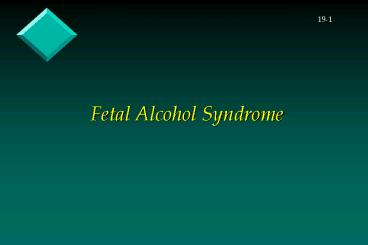Fetal Alcohol Syndrome - PowerPoint PPT Presentation
1 / 22
Title:
Fetal Alcohol Syndrome
Description:
Fetal Alcohol Syndrome. 19-2. Objectives. Participants will be able to: ... FAS: Fetal Alcohol Syndrome. ARBD: Alcohol-Related Birth Defects ... – PowerPoint PPT presentation
Number of Views:1262
Avg rating:3.0/5.0
Title: Fetal Alcohol Syndrome
1
Fetal Alcohol Syndrome
2
Objectives
- Participants will be able to
- State the definitions of FAS, ARBD, and ARND
- List the diagnostic criteria for FAS, ARBD, and
ARND - Understand the importance of identifying women
and children who are at risk - Become aware of office-based prevention
strategies and resources for families
3
Definitions
- FAS Fetal Alcohol Syndrome
- ARBD Alcohol-Related Birth Defects
- ARND Alcohol-Related Neuro-developmental
Defects
4
FAS
- Criteria 1 Alcohol use
- Binge drinking (gt2-3 drinks/occasion)
- Daily use (1-2 drinks/day)
- 1st trimester vs 3rd trimester use
5
FAS
- Criteria 2 Growth retardation
- decreased head circumference
- decreased height
- decreased weight
6
FAS
- Criteria 3 Facial malformation
- indistinct philtrum
- short palpebral fissures
- thin upper lip
7
FAS
- Criteria 4 Neurodevelopmental disorders
- impaired intelligence
- delayed speech development
- impaired fine motor skills
- attention deficit disorder
- attachment concerns
- learning disabilities
- hearing impairment
8
FAS Facial Features
9
Physical Abnormalities
- Cardiac
- Auditory
- Ocular
- Renal
- Skeletal
- Other
10
Prevalence
- General population
- FAS 3-10/10,000 live births
- Exposure 165,000 children born in the US in 1995
were exposed to potentially teratogenic doses of
alcohol - Women who are alcohol dependent
- 7 - 10 of children born with FAS
11
Alcohol Use During Pregnancy
- No known safe level of alcohol use
- 20 of pregnant women drink alcohol
- 3.4 drink two or more drinks per day or five or
more drinks per occasion
(CDC, 1995)
12
Prevention of Fetal Alcohol Exposure
13
Steps for Alcohol Screening Brief Intervention
Prior to Conception
14
ASK All Women About...
- Frequency of use
- Quantity of use
- Binge use
- Tolerance
- Partner use
- Family concerns
15
Screen for At-risk Drinking
- Non Pregnant Women
- Daily alcohol use
- more than 3 drinks per occasion
- more than 2 drinks to get high
- Partner use
- Family member concerns
- Pregnant Women
- Any use
16
Screening Opportunities
- Routine health examination
- Before prescribing interacting medication
- In response to problems that may be
alcohol-related - First prenatal visit
17
Recommendations for Low-Risk Drinking
- Women
- no more than 7 drinks per week
- or
- 3 drinks per occasion
- Pregnant Women (or those contemplating
pregnancy) - abstain
18
ASSESS
Ask about employment, family, and legal
problems Assess for evidence of physical
dependence Assess for alcohol-related health
problems
Step 1
Step 2
Step 3
19
ASSESS
Ask about readiness to change...
Step 4
Not ready
Maintenance
Ready
Action
20
ADVISE
- Discuss pregnancy, FAS, and alcohol
- Engage the patient in the process
- Provide a self-help booklet
- Establish drinking goals
Step 1
Step 2
Step 3
Step 4
21
ADVISE and REFER
Criteria for referral Access alcohol specialists
in the community Methods of referral Strategies
for resistant patients Strategies for those who
refuse to see a specialist or have no money
Step 1
Step 2
Step 3
Step 4
Step 5
22
Follow-up Patient Progress
Step 1
Follow-up phone call Repeat physician office
visit
Step 2
Refer to specialized treatment when needed































